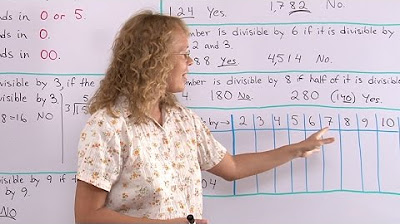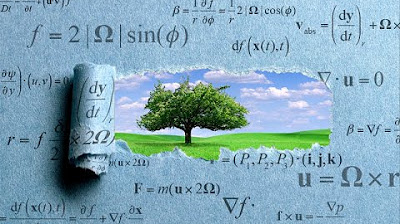Tesla’s 3-6-9 and Vortex Math: Is this really the key to the universe?
TLDRThe video script delves into the concept of vortex mathematics and the so-called '3-6-9 Tesla code,' exploring their origins and the mathematical principles behind them. It demystifies the vortex diagram, explaining its connection to digital roots and the divisibility rule for 9, and compares it to other mathematical diagrams generated by multiplication modulo different numbers. The video emphasizes that the vortex is not as unique as some believe, but rather a part of a broader mathematical phenomenon, and encourages a deeper understanding of mathematics as a key to understanding the universe.
Takeaways
- 🧠 The concept of vortex mathematics and the 3-6-9 Tesla code are recent phenomena that have gained popularity through viral videos on YouTube.
- 📊 The Vortex diagram, featuring 9 points on a circle and an infinity-shaped loop, is central to these discussions and is often linked to Nikola Tesla's fascination with the numbers 3, 6, and 9.
- 🔢 The digital root, a simple mathematical concept involving the sum of a number's digits until a single digit remains, is used to create sequences on the Vortex diagram.
- 🔄 The video explains that the digital root sequence for powers of 2 and powers of 1/2 (halving) is cyclical and that numbers 3, 6, and 9 are never visited in these cycles.
- 💡 The absence of 3, 6, and 9 in the digital root cycle is often interpreted as a divine message or secret code, but the video suggests a more straightforward mathematical explanation.
- 📚 The video connects the Vortex diagram to a famous sequence of diagrams representing positive integers, which eventually form the cardioid, known as the 'heart curve' in mathematics.
- 🔢 The digital root property of a number being divisible by 9 if and only if its digital root is 9 is a key point, and this is linked to divisibility tests taught in schools.
- 🔍 The video demystifies the Vortex by explaining it as a visualization of multiplication by 2 modulo 9, and that similar diagrams can be created for other numbers through modular multiplication.
- 🌌 The claim that the Vortex is the key to understanding the universe is challenged, with the video suggesting that it is just one of many mathematical diagrams and not as special as it is made out to be.
- 👽 The concept of digital roots and the significance of the number 9 can be generalized to other base systems, with the special number in base b being b-1.
- 🌀 The video invites viewers to explore the mathematical properties of the Vortex and other modular diagrams, highlighting their potential for deeper understanding and aesthetic appreciation.
Q & A
What is the main topic of the Mathologer video?
-The main topic of the Mathologer video is vortex mathematics and the 3-6-9 Tesla code, exploring the claims surrounding these concepts and their mathematical basis.
How is Nicola Tesla related to the concept of vortex mathematics?
-Nicola Tesla is related to vortex mathematics through his peculiar fascination with the numbers 3, 6, and 9, which are claimed by proponents of vortex mathematics to hold the key to the universe.
What is the significance of the VORTEX diagram in these videos?
-The VORTEX diagram is significant as it is used to visually represent the patterns and relationships in vortex mathematics, particularly the循环 of数字 roots and their connections to the numbers 3, 6, and 9.
What is the digital root of a number, and how is it calculated?
-The digital root of a number is the single digit obtained by repeatedly adding the digits of the number until a single digit remains. It is calculated by summing the digits of the number and, if necessary, continuing to add the digits of the resulting sum until a single digit is obtained.
How does the video explain the absence of the numbers 3, 6, and 9 in the cycle of digital roots?
-The video explains that the absence of the numbers 3, 6, and 9 in the cycle is due to the specific mathematical operations performed (doubling and halving), and not because of any divine message or secret code as suggested by some proponents of vortex mathematics.
What is the mathematical explanation for the patterns observed in the vortex?
-The mathematical explanation for the patterns in the vortex involves the properties of remainders on division by any number and the digital roots in the specific case of division by 9. The patterns arise from the repeated application of these properties in sequences of multiplication and division.
How does the video relate the digital root to divisibility tests taught in schools?
-The video relates the digital root to divisibility tests by showing that the digital root is essentially the remainder of a number on division by 9, which is a concept taught in schools for determining divisibility by 9.
What is the significance of the number 9 in base 10?
-In base 10, the number 9 is significant because the divisibility test for 9 and the digital root algorithm both rely on the property that any integer can be expressed as 9 times something plus its digit sum.
How does changing the modulus affect the appearance of the vortex diagram?
-Changing the modulus affects the appearance of the vortex diagram by altering the size and complexity of the loops and petals. Larger modulus values can result in more spectacular and intricate structures.
What is the connection between the vortex diagram and other diagrams shown in the video?
-The connection between the vortex diagram and other diagrams is that they all represent different cases of multiplication modulo a certain number, with the vortex being a specific case of multiplication by 2 modulo 9.
What challenge does the video pose for the viewers regarding the vortex diagram?
-The video challenges the viewers to explore the mathematical properties of the vortex diagram and other similar diagrams, such as understanding the modulus multiplication property and the structures within them, and to fill in the gaps in mathematical knowledge about these diagrams.
Outlines
🧠 Introduction to Vortex Math and the 3-6-9 Tesla Code
The video begins by introducing the concept of vortex mathematics and the 3-6-9 Tesla code, which are linked to the famous inventor Nikola Tesla. It mentions the popularity of these topics on YouTube and describes a diagram known as the VORTEX, which is central to these discussions. The video aims to explore the mathematical validity of these concepts and the significance of the numbers 3, 6, and 9 in Tesla's life and work.
🔢 The Digital Root and Its Repetition in Vortex Math
This paragraph delves into the method of calculating digital roots and how they are used in vortex math to create repeating sequences. It explains the process of doubling and halving numbers, calculating their digital roots, and arranging them on a circle. The video highlights the absence of the numbers 3, 6, and 9 in these sequences, which is interpreted by some as a divine message or secret code. However, it also hints at a more straightforward mathematical explanation for these phenomena.
📚 Mathematical Properties of Remainders and Digital Roots
The third paragraph focuses on the mathematical properties of remainders and digital roots, particularly in the context of division by 9. It explains how the remainder of the sum or product of two numbers equals the sum or product of their remainders. The video uses examples to illustrate these properties and introduces the concept of digital roots as a special case of these properties. It sets the stage for debunking the mystery surrounding vortex math.
🌀 Unraveling the Vortex: Multiplication Modulo and Digital Roots
This section of the video script explains the mathematical basis of the vortex diagram, describing it as a visualization of multiplication modulo 9. It clarifies that the digital root algorithm is applicable because of our base 10 number system, and that the vortex is not unique but one of many possible diagrams that can be generated using this principle. The video also invites viewers to explore the mathematical properties of these diagrams further.
👽 Alien Bases and the Generalization of the Vortex
The paragraph discusses the generalization of the vortex concept to different number bases, explaining how the special number in base b would be b-1, and how this would create a unique vortex diagram for each base. It uses the example of an 8-fingered alien to illustrate how the digital root in base 8 would connect in a similar but different pattern to the vortex in base 10. The video emphasizes that the vortex is not inherently special, but rather a product of our chosen number system.
🌟 The Beauty and Complexity of Mathematical Diagrams
The final paragraph of the script marvels at the beauty and complexity of the mathematical diagrams, particularly those with larger moduli. It mentions the cardioid and the unique loops that form in diagrams for prime numbers, highlighting the importance of these structures in mathematics. The video concludes by challenging viewers to further explore these diagrams and their properties, and to consider the broader implications of mathematics in understanding the universe.
Mindmap
Keywords
💡Vortex Math
💡Nikola Tesla
💡Digital Root
💡3-6-9 Sequence
💡Vortex Diagram
💡Cardioid
💡Modular Arithmetic
💡Divisibility Test
💡Base 10
💡Remainder
💡Times Tables
Highlights
The video discusses the concept of vortex mathematics and the 3-6-9 Tesla code, which are linked to the famous inventor Nikola Tesla and his fascination with the numbers 3, 6, and 9.
The vortex diagram, featuring 9 points on a circle and an infinity-shaped loop connecting 6 of the points, is a central topic in videos about vortex math.
Nikola Tesla's eccentricities included walking around the block three times before entering a building and preferring hotel rooms with numbers divisible by three.
The video explores the mathematical properties of the vortex diagram, which is part of a sequence of diagrams for each positive integer, leading to the cardioid curve, known as the mathematical heart curve.
The cardioid curve appears in various natural and mathematical phenomena, such as the shape made when rolling a circle around another circle of the same diameter and in the Mandelbrot set.
The video delves into the digital root concept, which involves adding the digits of a number until a single digit is obtained, and its relevance to the vortex diagram.
The absence of the numbers 3, 6, and 9 in the digital root sequence is often interpreted as a divine message or secret code in the context of vortex math.
The video provides a simple mathematical explanation for the phenomena observed in vortex math, related to divisibility tests and remainders.
The digital root of a number is not 9, then it is the remainder of that number on division by 9, a concept not commonly taught in schools.
The video explains the properties of remainders on division by any number and their digital root counterparts, particularly in the special case of 9.
The video demonstrates that the vortex diagram can be understood as a visualization of multiplication by 2 modulo 9.
The video compares the vortex diagram to other diagrams resulting from multiplication by 2 modulo different numbers, showing the variety of possible structures.
The video challenges the idea that the vortex is the key to the universe, suggesting that it is one of many similar diagrams and not as unique as some believe.
The video discusses the importance of multiplication modulo different numbers in various mathematical fields, such as finite fields and cryptography.
The video invites viewers to explore the mathematical properties of the vortex and other similar diagrams, suggesting they are a small part of the larger mathematical landscape.
The video concludes by emphasizing the importance of a deeper understanding of mathematics for comprehending the universe.
Transcripts
5.0 / 5 (0 votes)
Thanks for rating:





